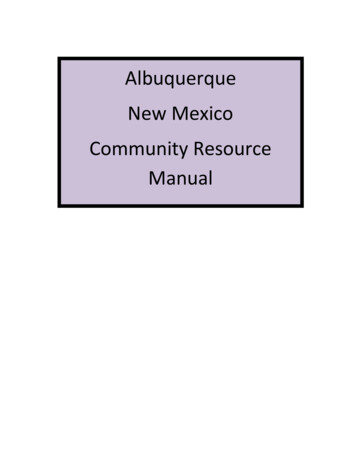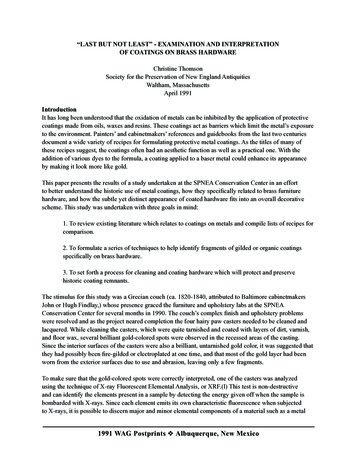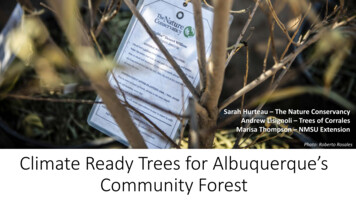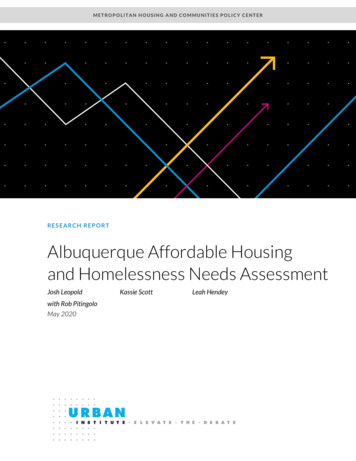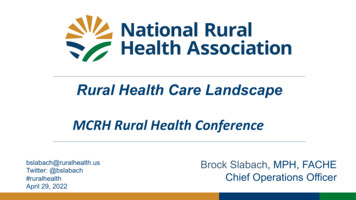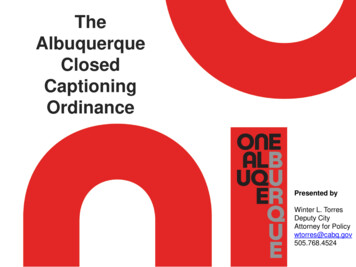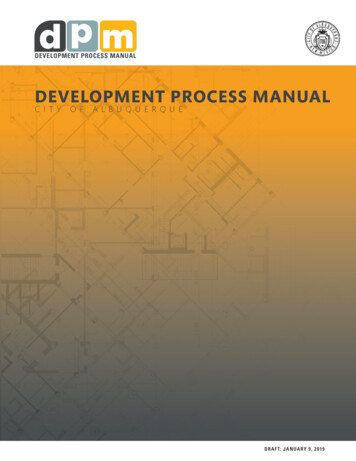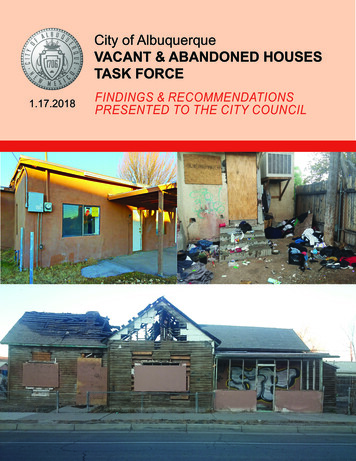
Transcription
City of AlbuquerqueVACANT & ABANDONED HOUSESTASK FORCE1.17.2018FINDINGS & RECOMMENDATIONSPRESENTED TO THE CITY COUNCILJanuary 17, 2018
CONTENTS1. EXECUTIVE SUMMARY1.1 Introduction1.2 Vacant and Abandoned Houses Task Force2. ive RecommendationsAdministrative RecommendationsEnforcementTechnology Improvements1113333453. LAND BANKS74. APPENDICES113.13.23.33.4IntroductionCase StudiesMoving Albuquerque ForwardPotential Funding SourcesA. GlossaryB. Defining the ProblemB.1 Substandard Properties ListB.2 Vacant Buildings RegistryB.3 Properties with the Most LiensB.4 Current Process for Vacant and Abandoned PropertiesC. Recommended Amendments to the Uniform Housing CodeD. Case Study: City of Tucson CodeE. Land Banks - Frequently Asked QuestionsF. Case Study: City of Las Cruces Affordable Housing Land Bank and Trust Fund PoliciesG. Resolution 17-230H. Bibliography7789131515151519212527314549
This page intentionally left blank.
1. EXECUTIVE SUMMARY1.1 INTRODUCTIONThe City of Albuquerque estimates that thereare approximately 1,200-1,300 residentialproperties that are vacant, abandoned, and/orsubstandard spread throughout the City, with a fewneighborhoods or areas where these properties areconcentrated. Foreclosure has started on some ofthese properties, leaving them in a state of limbo,and many are tax delinquent. Other contributingfactors include reverse mortgages, probate or theheirs are unknown, catastrophic damage to thestructure, lack of homeowners’ insurance, andgeneral poverty and the high rate of drug abuse inour community. These conditions have a negativeimpact to neighborhoods, families, and individualswho are seeking safety and security in theirhomes and maintenance of their property values.Enforcement on these properties have created adrain in City resources. This report is a summaryof the Vacant and Abandoned Houses Task Forcefindings and recommendations for the City Councilto consider in abating these conditions.The City’s Uniform Housing Code defines thefollowing terms that are used throughout this report: Vacant Building - A dwelling, dwelling unit,efficiency dwelling unit, habitable space,residential building, or structure lacking thecontinuous habitual presence of humanbeings who have a legal right to be on thepremises for a period of 90 days or longer butexcluding property under a listing agreementwith a real estate agent licensed in NewMexico. Substandard Building - Any building or portionthereof, including any dwelling unit, guestroom or suite of rooms, or the premises onwhich the same is located, in which thereexists any of the following listed conditions[set forth in §§ 14-3-4-2 et seq.] to anextent that endangers the life, limb, health,property, safety or welfare of the public orthe occupants thereof shall be deemed anddeclared a Substandard Building.1.2 VACANT AND ABANDONED HOUSESTASK FORCEIn September 2017, the Albuquerque CityCouncil adopted R-2017-185, which created a7-member task force to explore options and makerecommendations for addressing vacant andabandoned houses within the City of Albuquerque.The Resolution acknowledged the myriad ofchallenges in addressing this issue including: Enforcement of minimum health and safetyrequirements for vacant or abandonedresidential properties; The City staff and resources needed tomonitor over 600 properties that are eitheralready a public nuisance or are in danger ofbecoming a public nuisance, and the arduousprocess of nuisance abatement enforcementthat is presently overwhelming availableresources; and The potential negative impact on propertyvalues and resale of homes and the disruptionof the quality of life in Albuquerque’sneighborhoods due to dilapidation andpotential attraction of illicit activities.The Task Force, comprised of City staff from CodeEnforcement, Family and Community Services,Legal Department, Council Services, Mayor’sOffice, two community members, and one planningconsultant (Consensus Planning), was asked toexplore alternative methods of addressing vacantand abandoned houses that would ultimately helpreduce property crime and better leverage Cityresources. Specific issues explored were as follows: Options for efficient enforcement methodsto address the most pressing problemsVACANT & ABANDONED HOUSES TASK FORCE - ALBUQUERQUE CITY COUNCIL REPORT1
associated with vacant and abandonedhouses; Options for collaborative and proactiveprograms to prevent the dilapidation ordeterioration of such houses; Options for the City to help facilitaterecommissioning such houses for people andfamilies; and Any other relevant and helpful options relatingto this issue.The Task Force held eight meetings starting onOctober 25, 2017. Two of the meetings includedconference calls - one with the Philadelphia LandBank and one with the Center for CommunityProgress, a national non-profit organization thatprovides technical assistance to communitiesgrappling with transforming blighted, vacant, andother problem properties back into productive use tosupport neighborhood vitality.The Task Force acknowledges that the workcompleted since October is just the beginning stepsfor addressing these issues, and is ready and willingto continue working on behalf of City Council.2VACANT & ABANDONED HOUSES TASK FORCE - ALBUQUERQUE CITY COUNCIL REPORT
2. RECOMMENDATIONS2.1 INTRODUCTIONThe Task Force created a series ofrecommendations for the City Council to considerin addressing the issues associated with vacant,abandoned, and substandard properties. Therecommendations are based on research of bestpractices from other municipalities, discussionswith other governmental entities and non-profitorganizations, and the fact that the City’s UniformHousing Code has not been updated in many years.The recommendations are listed in the categoriesof legislative, administrative, enforcement, andtechnology improvements.2.2 LEGISLATIVE RECOMMENDATIONS1. Explore the establishment of a City-managedland bank for acquisition and dispositionof vacant and abandoned properties. Thisshould include an initial assessment andtechnical assistance from the Center forCommunity Progress (see Section 3: LandBanks).2. Revise violations of the Uniform HousingCode provisions to allow for imposing civilpenalties instead of criminal penalties toexpedite the process. If civil proceduresare found to be insufficient, two additionalmethods for addressing non-complianceinclude: (1) appointment of a receiveror conservator where a judge appointssomeone to repair or rehabilitate a problemproperty; and (2) injunctive relief wherethe hearing officer or administrative judgerequires the responsible party to take aspecific action or face serious consequences.3. Pursuant to Section 14-3-5-15, amend thecomplaint system that includes both a hotlineand a website component for reportingviolations of the Property MaintenanceOrdinance.4. Explore legislative options at the Statelevel for extending the statute of limitationsregarding collection of municipal liens.5. Explore legislative options to allowreceivership statuses and/or appointmentof a conservator for parties of interest, suchas non-profit organizations, recognizedneighborhood associations, communitydevelopment corporations, and other interestgroups. (Pennsylvania's Abandoned andBlighted Property Conservatorship Act, whichallows the court to appoint a conservator torehabilitate and be responsible for bringingthe deteriorating building into compliance, isa model to follow).6. Add new definitions to the City’s UniformHousing Code (see Glossary in Appendix).2.3 ADMINISTRATIVE RECOMMENDATIONS1. Implement and maintain a SubstandardProperty Registry that is coordinated with theCity's existing Vacant Property Registry.2. Establish a progressive fee for registrationof vacant and abandoned houses to helprecover the cost of Code Enforcement. Inestablishing the registration fee, consider thefollowing: The registration fee should not be setso high that it discourages people fromregistering; and Establish a progressive fee structure thatincreases each year the property remainsvacant.3. Redirect Code Enforcement fees collected bythe City from the General Fund to the CodeEnforcement Division budget to recoverenforcement costs and to increase staffinglevels.4. Waive fees after one year if the owner orresponsible party demonstrates that theyare adequately maintaining and securing avacant property.5. Focus Code Enforcement activities in theneighborhoods and districts with the mostproblematic properties by utilizing the VacantBuilding Registry and the new SubstandardProperty Registry and on-line map (seeRecommendation 2.5.1).6. Through the Office of NeighborhoodCoordination, provide resources, support,and training to neighborhood associationson the procedures for notifying theVACANT & ABANDONED HOUSES TASK FORCE - ALBUQUERQUE CITY COUNCIL REPORT3
Code Enforcement Division of vacant,abandoned, or substandard properties (seeRecommendations 2.5.1 and 2.5.2).7. Increase partnership and coordinationbetween different agencies, departments,established neighborhood groups, andlocal non-profits with an interest in issuespertaining to vacant, abandoned, andsubstandard properties, such as: Code Enforcement Division County Assessor’s Office City Department of Technology andInnovation Environmental Health Department Albuquerque Police Department COAST Safe City Strike Force Albuquerque Fire Department Housing Advisory and AppealsCommittee (HAAC): This Committee actsas an advisory body to the Departmentof Human Services in the administrationand enforcement of the Uniform HousingCode and provides other functions thatmay be provided for elsewhere.8. The Office of Neighborhood Coordinationshould coordinate with the NeighborhoodWatch Program to conduct "neighborhoodsweeps" to identify problem properties.2.4 ENFORCEMENT RECOMMENDATIONS1. Adopt a new policy that prohibits buildingpermits or business registrations beingissued by the City for any property that hasoutstanding City of Albuquerque liens. Thisapplies to any liens for board-up, clean-up,Solid Waste, and Certificate of Substandardliens until they are paid in full or the propertyowner or responsible party agrees to apayment plan that is signed and approved bythe City.2. Enforce registration of vacant propertiesand provide penalties to owners/responsibleparties of vacant properties for noncompliance.3. Impose civil penalties on mortgage holdersfor maintenance of “zombie properties” andincrease their exposure for premises liability4claims related to those properties. Thisapproach could be modeled after the State ofNew York legislation (2016), which imposes adaily penalty for non-compliance by state andfederally-chartered banks, savings banks,savings and loan associations, and creditunions. The penalty only applies to the firstlien mortgage holder that is authorized toaccept payment of the loan.4. Require owner or responsible party of vacantproperty to maintain liability insurance. (Thisis similar to the City’s HEART Ordinance,which requires dog owners to maintaininsurance for dogs that have been declareddangerous).5. Require owner or responsible party tocreate a detailed property plan that includesa timeline for maintaining, rehabilitating,reoccupying, or demolishing the problemproperty.6. Impose civil penalties on property owner orresponsible party for the cost imposed on thelocal government as a result of increased fire,police, and building inspection actions at theproperty. Require the assessment to be paidupon the filing of a foreclosure deed.7. In collaboration with Bernalillo County,identify vacant or abandoned propertieswith delinquent taxes to force transfer ofownership through a number of methods,such as expedited judicial foreclosureprocess, court appointed receivership, orautomatic sale or transfer to a land bank.2.5 TECHNOLOGY IMPROVEMENTRECOMMENDATIONS1. Create, maintain, and update an on-line mapof vacant, abandoned, and substandardproperties. The Code Enforcement Divisionshould manage and make this map availableto neighborhood association representativesupon request. The on-line map shouldinclude aggregated data from the City’sVacant Building Registry and SubstandardProperty Registry to identify the mostproblematic areas of the City, but not showindividual properties. Once this system is inplace, Code Enforcement and the Office ofVACANT & ABANDONED HOUSES TASK FORCE - ALBUQUERQUE CITY COUNCIL REPORT
Neighborhood Coordination should work onadvertising this new complaint system to thepublic in the Neighborhood Newsletter.2. Expand the use of the Planning Department’ssoftware tracking system to allow the publicto view the status of vacant, abandoned, andsubstandard buildings.3. Consider allowing the Vacant PropertyRegistry to be managed by a third party. ProChamps, based out of Florida, is an exampleof a third party company that partners withmunicipalities to manage vacant propertiesand provides technical assistance onassessing housing stock and market, draftingproperty registration ordinances, identifyingresponsible parties and ensuring compliancewith registry requirements, maintaining theregistry, and collecting data to quantify costsavings in time and resources.VACANT & ABANDONED HOUSES TASK FORCE - ALBUQUERQUE CITY COUNCIL REPORT5
This page intentionally left blank.6VACANT & ABANDONED HOUSES TASK FORCE - ALBUQUERQUE CITY COUNCIL REPORT
3. LAND BANKS3.1 INTRODUCTIONThe Center for Community Progress estimatesthat as of June 2017, there are approximately 170land banks operating across the United States(see Appendix E: Land Banks - Frequently AskedQuestions). There is a concentration of land banksin the rust-belt“The essential function of a land bank isstates of Ohio,the ability to streamline tax foreclosureIllinois, Michigan,proceedings and clear title to property thatand New York,reverted to public ownership. This functionallows communities to plan for the reusemost of whichof properties that previously were difficultwere establishedto acquire and redevelop, and to protectat the state levelneighborhoods from the blight and declineoften associated with tax-foreclosedby their Attorneysproperties.” US Environmental ProtectionGeneral. ThereAgency, Land Revitalization Fact Sheet,Land Banking.are also landbanks establishedor in the process of being established in NewMexico for the purpose of addressing the need foraffordable housing, including the City of Las Cruceswhich is scheduled for adopting legislation thismonth (January 2018), and the Village of Ruidoso.Described in the article “What is a Land Bank” (DanKildee and Amy Hovey, Center for CommunityProgress), land banks can sell or convey acquiredproperty as follows: Sell through negotiated sales; Convey property for other than monetaryconsideration; Sell, lease, or manage property with termsdeemed to be in the interest of the land bank; Utilize land bank financing tools for taxforeclosed and other targeted properties; and Support local planning decisions by adheringto local priorities as to use and transfer of landbank owned properties.The article lists the four critical elements to creatinga successful land bank initiative: Connect the land bank to the tax collectionand foreclosure system (delinquent propertytax is a first priority debt, higher than mortgagedebt). Scale the land bank at the metropolitan level,or around the most diverse real estate marketpossible (i.e., land banks are most effectivewhen they are not relegated to ownership ofonly the worst of the foreclosed or abandonedproperties). Ensure a land bank is policy driven andtransparent in policies and transactions. Emphasize community engagement andparticipation (i.e., Albuquerque neighborhoodassociations).3.2 CASE STUDIESA description of several land banks are describedbelow: City of Las Cruces - The City of Las Crucesis scheduled to adopt legislation referred toas the “Affordable Housing Land Bank andTrust Fund Policies” on January 16, 2018.The City’s intent is to establish a Land Bankand a Housing Trust Fund that is gearedto address the “full continuum of housingneeds from the homeless to the homebuyer,especially in the area of affordable housing”.The ordinance provides the land bank with theauthority to acquire real property or interestsin property by gift, transfer, exchange,foreclosure, condemnation, lease, purchase,or with other terms or conditions that theland bank considers appropriate. The landbank’s authority also includes acquisitionthrough purchase contracts, lease purchaseagreements, installment sales contracts,and land contacts, and transfers. Theordinance includes a provision for determiningwhether to acquire a property, that the landbank considers a wide range of qualitative,quantitative, physical, and property statusfactors listed in the ordinance. The ordinancealso provides guidance for disposition of theacquired properties (for more detail on theCity of Las Cruces Land Bank, see AppendixF: Case Study: City of Las Cruces AffordableHousing Land Bank & Trust Fund Policies). State of New York - Established in 2013,the “Land Banks Community RevitalizationInitiative” is a grant program administeredby the State Attorney General of New Yorkthat distributes funds from a settlement withbanks involved in the mortgage crisis. NewYork land banks have reclaimed at least1,995 properties from abandonment, returnedVACANT & ABANDONED HOUSES TASK FORCE - ALBUQUERQUE CITY COUNCIL REPORT7
over 700 properties to the market and intoproductive use, and have demolished (orare in the process of demolishing) over 400unstable structures. State of Ohio - Established by the State ofOhio’s Attorney General in 2012, the “OhioAttorney General’s Moving Ohio ForwardProgram” was initiated following a settlementwith mortgage lenders. Land banks fromacross Ohio partnered with Habitat forHumanity, NeighborWorks, and otherorganizations to demolish blighted structures,rebuild, and turn them back into property taxgenerating, productive use. Officials notedthat neighboring property owners begantaking better care of their property afterrestoration had occurred. State of Illinois - The Illinois Attorney Generalused funds obtained through a 2012settlement with mortgage companies toassist housing efforts throughout the state.The Cook County Land Bank was seededwith 6M and has since acquired over 300properties, most of which are blighted homes.Before selling these properties, the Land Bankcleans liens, fines, and other red tape off theproperty’s title. The Land Bank sold over 230of these blighted homes to rehab companies,who in turn, have revitalized them intoproductive use. The Cook County Land Bankhas become self-sustaining and does not usetaxpayer funds for operations. Michigan - Established in 2004, the “LandBank Fast Track Legislation” was intendedprovide communities with better legal andfinancial tools to put vacant and abandonedproperties back into productive use. Thelaw established state land bank authorityand enabled the establishment of city andcounty land bank authorities. The law allowsthese local authorities to expedite quiet titleon its properties, thereby eliminating all liensand past claims, and make them availableat a nominal price. The Genessee CountyLand Bank Authority is the largest operatingland bank in the country with over 10,000acquisitions of properties and structures sinceits inception. There are many other land banksin Michigan that operative with much smaller8inventory and only use the land bank tools ona few properties each year. Fort Collins, Colorado - Adopted by the Cityof Fort Collins in 2001, the purpose of theFort Collins Land Bank is to acquire, hold,and sell property to assist affordable housingdevelopers to build housing for low incomehouseholds at or below 50% average medianincome (AMI). This program is much smallerin scope than the previous examples fromNew York, Ohio, Illinois, and GenesseeCounty.3.3 MOVING ALBUQUERQUE FORWARDThe Task Force recommends that the City furtherexplore the establishment of a land bank as oneof the most important changes that the City ofAlbuquerque could implement to address the returnof vacant, abandoned, and tax-delinquent propertiesinto productive use. As a home rule municipality,the City has the ability to adopt new legislation toestablish a land bank without the requirement ofstate-enabling legislation (see Appendix F: CaseStudy: City of Las Cruces Affordable Housing LandBank & Trust Fund Policies).It is acknowledged that a future land bank forAlbuquerque would likely be modest in scalerelative to the number of properties in its inventoryat any one time. As a first step, the City shouldengage with the non-profit, Center for CommunityProgress for technical assistance in creating aland bank that is specifically crafted to legal andadministrative conditions, and fiscal constraints inAlbuquerque.The Task Force recommends that the CityCouncil, as part of adopting legislation thatestablishes a land bank, establish an appointedadvisory board that is tasked with identifying andacquiring targeted, tax-delinquent and foreclosedproperties, as well as receiving donated properties.Membership is recommended to include, but notbe limited to, City staff from the Code Enforcementand Real Property Divisions of the PlanningDepartment and Community Development Divisionof the Family and Community Services Department;neighborhood representatives; representativesfrom a locally-owned bank, locally-owned mortgagecompany, and a non-profit community developmentcorporation that specializes in housing rehabilitationand development.VACANT & ABANDONED HOUSES TASK FORCE - ALBUQUERQUE CITY COUNCIL REPORT
The Task Force recommends that the land bankestablish a process for assessment and acquisitionthat includes: Collecting data on property condition,ownership status, tax history, utilityinformation, emergency calls, foreclosures,occupancy status, existing liens, CodeEnforcement costs, etc. Based on the data collected, determiningpriorities for acquisition of properties that posethe greatest harm to the neighborhoods inwhich they are located. In addition to acquisition, structuring theland bank to receive donations of problemproperties (land and/or structures) Civil penalties and registration fees - civilpenalties and registration fees for vacant andsubstandard buildings collected by the Citycould be directed to the Albuquerque LandBank. Charitable contributions - coordinate withBernalillo County on a provision that allowsentities to be eligible for a property taxcredit (dollar for dollar reduction) or taxdeduction (lowers taxable income equalto the percentage of the entity's marginaltax bracket) when they make charitablecontributions to the Albuquerque Land Bank.3.4 POTENTIAL FUNDING SOURCES Foundation grants - land banks are typicallyeligible for foundation grants due to itscorporate structure or governmental status. Land sales revenue - generated when theland bank sells properties for more than theacquisition cost incurred by the land bank.Land banks are able to acquire property atbelow market value in a variety of ways: Land banks are able to accept donatedland. Property owners may want todonate their land for the tax benefitsor even to relieve themselves of themaintenance obligations for the property.It is advisable that the land bank conductproper due diligence prior to acceptingdonated property. It is appropriate for aland bank to provide a letter of acceptancefor donated properties, but not todesignate a donative value to the donor rather it should advise donors to consulttheir tax professional for assistance indetermining the tax implications for thedonor. A land bank may purchase low valueproperties at auctions, although it wouldbe bidding against other buyers. City General Fund - the City Council couldinclude a line item for seeding the land bank.VACANT & ABANDONED HOUSES TASK FORCE - ALBUQUERQUE CITY COUNCIL REPORT9
This page intentionally left blank.10VACANT & ABANDONED HOUSES TASK FORCE - ALBUQUERQUE CITY COUNCIL REPORT
APPENDICESA. GlossaryB. Defining the ProblemB.1 Substandard Properties ListB.2 Vacant Buildings RegistryB.3 Properties with the Most LiensB.4 Current Process for Vacant and Abandoned PropertiesC. Recommended Amendments to the Uniform Housing CodeD. Case Study: City of Tucson CodeE. Land Banks - Frequently Asked QuestionsF. Case Study: City of Las Cruces Affordable Housing Land Bank and Trust Fund PoliciesG. Resolution 17-230H. BibliographyVACANT & ABANDONED HOUSES TASK FORCE - ALBUQUERQUE CITY COUNCIL REPORT13151515151921252731454911
This page intentionally left blank.12VACANT & ABANDONED HOUSES TASK FORCE - ALBUQUERQUE CITY COUNCIL REPORT
A. GLOSSARYThe following list of terms do not appear in the Cityof Albuquerque’s Code of Ordinances. The TaskForce recommends including these terms in theCity’s Uniform Housing Code for the purpose ofstrengthening the vacant and abandoned propertyabatement process. Suggested definitions beloware examples from other municipalities.Abandoned property (see Problem propertiesbelow)Abate - to bring to a halt, eliminate or, where thatis not feasible, to suppress, reduce, and minimizesubstandard conditions or blighting related toresidential properties.Deteriorated property (see Problem propertiesbelow)Distressed property (see Problem propertiesbelow)Evidence of vacancy - any visual cues thatdetermine if a property is unoccupied. Such visualcues include, but are not limited to, overgrownand/or dead vegetation; accumulation of mail;accumulation of trash, having one (1) or more of therequired utilities inactive, etc.Foreclosure - the system by which a party whohas loaned money secured by a mortgage or deedof trust on real property requires sale of the realproperty to recover the money due, unpaid interest,plus the costs of foreclosure, when the debtor failsto make payment.Foreclosure sale - the forced sale of real propertyat a public auction (often on the courthouse stepsfollowing public notice posted at the courthouse andpublished in a local newspaper) after foreclosure onthat property as security under a mortgage or deedof trust for a loan that is substantially delinquent.The lender who has not been paid may bid for theproperty using its own unpaid note toward payment,which can result in a bargain purchase.Land bank - a governmental or non-profit entitythat specializes in the conversion of vacant,abandoned, and foreclosed properties intoproductive use. 1) Land banks act as a legaland financial mechanism to transform vacant,abandoned, substandard, and tax-foreclosedproperty back to productive use. Generally, landbanks are funded by local governments’ budgets orthe management and disposition of tax-foreclosedproperty. 2) In addition, a land bank is a powerfulincentive that can encourage redevelopment inolder communities generally with little available landand neighborhoods that have been blighted by anout-migration of residents and businesses.(3) Whilea land bank provides short-term fiscal benefits,it can also act as a tool for planning long-termcommunity development. Successful land bankprograms revitalize blighted neighborhoods anddirect reinvestment back into these neighborhoodsto support their long-term community vision.Lien - any official claim or charge against propertyor funds for payment of a debt or an amountowed for services rendered. This includes vacantproperties that have been found to be in violationof the City’s Anti-Weed and Litter Ordinance or theUniform Housing Code Ordinance, the violation hasnot been corrected in the time given, a work orderis created to have the work completed, and a lienis filed with the County Clerk’s Office against theproperty for the cost of the work performed. A liencarries with it the right to sell property, if necessary,to obtain the money. Most liens are enforceablein the order in which they were recorded or filed,except tax liens which have priority over a privatecitizen’s claim.Lis pendens - a written notice that a lawsuit hasbeen filed and then recorded with the CountyClerk's Office concerning the title to real property orsome interest in that real property.Local agent (see Problem properties below)Local property management company (seeStakeholders below)Owner - (see Stakeholders below)Problem properties - properties that destabilizeneighborhoods, create fire and safety hazards,drive down property values, and drain local taxdollars. This includes any structure being used forsleeping, eating, shelter, etc. no matter the intendeduse of the structure. Below are examples of suchproperties and suggested definitions: Abandoned property - any vacantresidential building which is frequented bypersons who are not lawful occupants of suchVACANT & ABANDONED HOUSES TASK FORCE - ALBUQUERQUE CITY COUNCIL REPORT13
structure; or any vacant residential buildingdue to lack of maintenance or by boarding upof its doors and windows, or other reasons,has a substantial adverse effect on the valueof property in the immediate neighborhood;or a residential building where the principaluse has ceased and that no longer has anyfunction or use. Deteriorated property - any dwelling unitlocated in a deteriorated neighborhood;a dwelling unit which has been, or, uponrequest, is certified by a health, housing orbuilding inspection agency as, unfit for humanhabitation for rent withholding, or other healthor welfare purposes; or a dwelling unit whichhas been the subject of an order by suchan agency requiring the unit to be vacated,condemned or demolished by reason ofnoncompliance with laws, ordinances orregulations. Distressed property - any property that issubject to a current notice of default and/ornotice of trustee’s sale, pending tax assessorslien sale and/or any real property conveyedvia a foreclosure sale resulting in theacquisition of title by an interested beneficiaryof a deed of t
In September 2017, the Albuquerque City Council adopted R-2017-185, which created a 7-member task force to explore options and make recommendations for addressing vacant and abandoned houses within the City of Albuquerque. The Resolution acknowledged the myriad of challenges in addressing this issue including:
